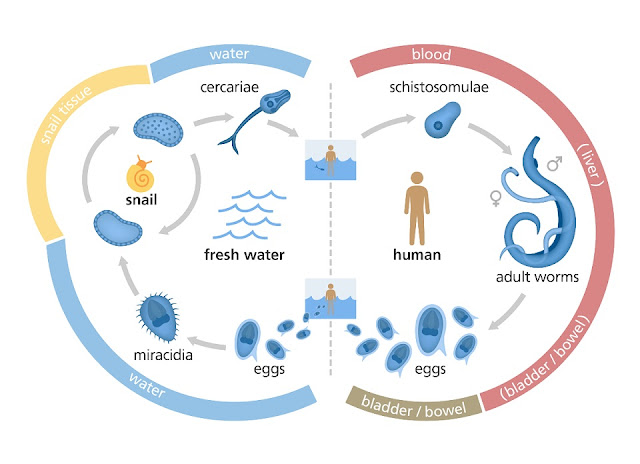General characteristics
1. They
are elongatedly cylindroidal in shape with prominent oral and ventral sucker.
2. They
have separate sexes (dioecious).
3. Absence
of muscular pharynx
4. Intestine
bifurcates and unites at a certain level to form the united intestinal ceca.
5. The
male adult are provided with gynecophoral canal on the ventral side, the
function of which is to cuddle the female throughout its entire life except
during oviposition. Since they are always in perpetual copula, they are known
as the most romantic parasites.
6. Their
life span may be as long as 30 years.
7. They
are the only trematodes found in the bloodstream, they can also be isolated in
stool and urine.
8. Ova
are embryonated and not operculated.
9. They
are the only trematode which requires one intermediate host.
10. Since
they have no metacercaria, the infective stage is the cercaria which has a characteristic
fork–tailed appearance.
****** SCHISTOSOMA JAPONICUM ******
Common name: Oriental blood fluke
Synonyms: Sinobilharzia
japonica (Katayama’s disease)
1. Adult
a. Male
adult measures 12 – 20 mm and 0.5 mm in diameter, oral and ventral suckers
located near the anterior end of the worm; considered as the biggest of all
blood flukes; cuticles are smooth and non–tuberculated, provided with 6–9 testes
arranged in rows. Intestinal ceca bifurcates, then fuses very posteriorly.
b. Female
adult measures 26 mm x 0.3 mm (longer and more slender), more than one
esophageal bulb with fine cuticles, ovary located centrally, uterus is long and
well–developed with 50 –100 eggs, the female is usually found held in the
gynecophoric canal of the female, the females are capable of laying about 1500–3500
eggs per day (most destructive).
2. Ova is 75–100 x
50u, broadly ovoidal in shape with very characteristics cellular debris, it has
a rudimentary or abbreviated lateral spine, the shell stained acid fast,
sloping shoulder miracedium inside.
Habitat:
Superior mesenteric plexus and ocassionally
the inferior mesenteric and portal venous system
Intermediate host: Oncomelania
quadrasi
Reservoir host: Dogs,
cats, mice, cattle, pigs, goats
Life cycle
****** SCHISTOSOMA MANSONI ******
Common name: Manson’s blood fluke
Disease: Manson’s intestinal schistosomiasis
or bilharziasis
Morphology:
1. Adult
a. Male
measure 6–12 x 1 mm, coarse tuberculation, lateral margins interlock and are
held in position by acuminate spines which are longer than the other
integumentary ones, minutes sensory papilles are distributed over the surface
and the tuberosities are provided with microscopic tufts of the hair. There’s
early union of the intestinal ceca; 3–13 small testes arranged in clusters.
b. Female
measure 7–17 x 0.25 mm with only one esophageal bulb; early union of intestinal
ceca; ovary located anteriorly with a short uterus containing 1 – 4 eggs; females
are capable of laying 10–300 eggs per day.
2. Ova
measures 114 – 175u and has a very prominent lateral spine
Habitat
Inferior mesenteric plexus or portal
venous sytem
******* SCHISTOSOMA HAEMATOBIUM *******
Common name: Vesical blood fluke
Disease: Vesical schistosomiasis,
schistosomal hematuria
Vesical
or urinary bilharziasis
Morphology:
1. Adult
a. Male
has shorter, stouter organism, measuring 10–15 x 0.8–1 mm. It has fine
tuberculation and has 2 suckers (ventral is larger); behind the ventral sucker,
the body of the male is infolded ventral all the way to the caudal extremity to
form the gynecophoral canal, there is late union intestinal ceca, there are 4 –
5 tested arranged in clusters or columns.
b. Female
are long and slender, measuring 20 x 0.25 mm, the suckers are small, subequal
and are not conspicuously muscular; ovary located at the posterior end with a
long uterus containing 20 to 30 eggs, the female is capable of producing 20–290
eggs per day.
2. Ova
measures about 120u and is provided with a very characteristic terminal spines.
Habitat:
Vesical and pelvic plexuses of the
venous circulations
Intermediate Hosts: Bulinus, Planorbis
Life cycle
Life cycle



















No comments:
Post a Comment